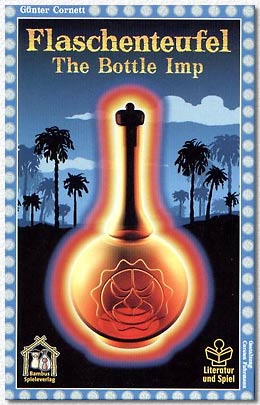
| Designer | Günter Cornett |
| Publisher | Bambus Spieleverlag |
| released | 2003 |
| Players | 3-4 |
| Playing Time | 45 minutes |
 |
||||||||||
|
||||||||||
reviewed by Moritz Eggert
Günter Cornett has a great talent for inventing interesting trick-taking games with a twist, and "Bottle Imp" is no exception.
In this game, each player gets a distribution of 36 cards (numbered 1-18 and 20-37) in three colours. The trick is won by the player who played the highest card of the same colour (or any colour if he is out of the colour) which is the highest lower card as the current "bottle imp", or, if nobody played a card below the imp's number, simply the highest card. The bottle imp starts at "19" (for which there is no card), so the player playing the only 18 in the game would win the trick, but also a player playing 17 or lower if he was the highest "below-the-imp" player. However, that also means that the bottle imp is now placed on the 18 (or the highest lowest card that was played), and the next trick-taking play has to be 17 or lower. The player who is stuck with the bottle imp after the last card is played gets the imp's cards (see below) counted in the negative, all the other players get positive points.
Of course this is not as simple as it sounds. At the beginning of a round players pass two of their cards to their neighbours, and one card into the "imp's pile". So there is never any absolute certainty about which cards are actually in the game. Of course it is not a good tactic to keep your 1's and 2's for the last trick, because this usually means you get the bottle imp. Therefore it is common that if a player plays an imp trick (for example the 15) all other players will get rid of their lowest cards, because they won't win the trick for certain and don't end up with the imp (represented as a little wooden bottle) either. If you play a low card as a starter, other players might deliberately play their higher cards so you end up with a low imp early in the game, and the other players simply win the tricks by playing higher cards than your imp, in effect the game will pass you by with an evil grin of everybody involved.
"The Bottle Imp" is not only a clever game, but also lovingly crafted around a famous short story of Robert Louis Stevenson, which, as an additional bonus, is fully included with the game, in German AND English (as are the rules). Luck of the draw might play a role, as if you have many very low cards in your initial draw it will be very difficult to get rid of all of them at the right time. Still this is a very enjoyable card game that doesn't leave the brain out of work and also has a high "fun through torture of other players" factor. Recommended!
Explanation time: 5 minutes
Playing time:1 round 5 minutes, full game 1 hour
| add/read comments |
©2005, Westpark Gamers